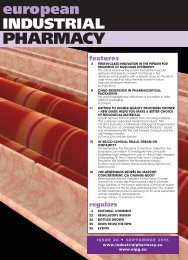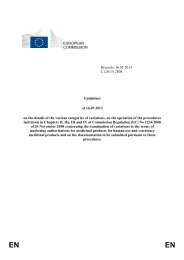PHARMACY
eip31-dec16
eip31-dec16
You also want an ePaper? Increase the reach of your titles
YUMPU automatically turns print PDFs into web optimized ePapers that Google loves.
FORMULATION TECHNOLOGY CAN ENABLE ORAL DELIVERY OF NEW GENERATION MEDICINES<br />
continued<br />
endpoint was not attained, a<br />
statistically significant percentage<br />
reduction in Disease Activity Index<br />
(DAI) at week 6 of therapy relative<br />
to baseline DAI, there was a<br />
prolonged reduction in mean DAI in<br />
the treatment arm relative to<br />
placebo for weeks 18–30 post-start<br />
of treatment 23 .<br />
In a bioavailability study of rectally<br />
delivered alicaforsen, it was found<br />
that colonic tissue levels of drug<br />
were orders of magnitude higher<br />
than those found in plasma. The<br />
plasma levels of alicaforsen found<br />
represented 0.6% bioavailability of<br />
the drug 24 . The low systemic<br />
exposure and high tissue levels may<br />
support the use of topical ASOs to<br />
enable efficacy whilst avoiding the<br />
infusion-related reactions seen with<br />
intravenous therapy, which may be<br />
associated with cytokine release<br />
syndrome 25 (a systemic<br />
inflammatory response similar to<br />
that seen with severe infections,<br />
with symptoms including fever,<br />
hypotension and rigors). Alicaforsen<br />
enema has been licensed by its<br />
innovator Ionis Pharmaceuticals<br />
(formerly Isis Pharmaceuticals) to<br />
Atlantic Healthcare who have<br />
recently initiated Phase 3 clinical<br />
trials in pouchitis, which is<br />
inflammation of an ileal pouch<br />
surgically made out of small bowel<br />
and created in the management of<br />
ulcerative colitis patients who have<br />
undergone surgical removal of the<br />
large bowel 26 .<br />
Multiple immune system<br />
pathways appear to operate in IBD<br />
and so alternate targets for<br />
potential therapeutic intervention<br />
can be beneficial. Cobitolimod<br />
(DIMS0150, Kappaproct ® ) induces<br />
the activation of the Toll-like<br />
receptor 9 (TLR9) pathway in the<br />
effector cells present on mucosal<br />
surfaces resulting in the localised<br />
production of anti-inflammatory<br />
cytokines such as interleukin-10 (IL-<br />
10). This also restores the subject’s<br />
sensitivity to steroids 27 . Cobitolimod<br />
is a 19 base pair ASO that is not<br />
significantly systemically absorbed<br />
when administered topically inside<br />
the large intestine. The local action<br />
and limited absorption may<br />
contribute to a favourable<br />
therapeutic index 28 . In one study in<br />
eight chronic active ulcerative colitis<br />
patients, a single 30mg dose in<br />
50mL of vehicle topically to the<br />
colon epithelium during<br />
colonoscopy (in one subject three<br />
doses each 4 weeks apart) was<br />
administered via a spraying<br />
catheter. After treatment, there was<br />
positive clinical response.<br />
Endoscopy showed improvement at<br />
week 1, and by week 12 posttreatment<br />
86% of subjects exhibited<br />
a clinical response with 71% in<br />
remission.<br />
Subsequently, steroid doses could<br />
be reduced 27 . In a small, placebocontrolled<br />
study, 30mg of<br />
cobitolimod was administered<br />
rectally in 50mL of water for<br />
injection via a catheter inserted in<br />
the bowel lumen. Although a<br />
sustained clinical improvement in<br />
disease in subjects in the treatment<br />
group was seen, the statistical<br />
power limitations of the study did<br />
not allow proof of primary or<br />
secondary endpoints 29 . Going<br />
forwards, trials utilising the ability to<br />
select patients most likely to<br />
respond to cobitolimod treatment<br />
by use of biomarkers and so<br />
improve its therapeutic utility have<br />
been suggested 30 .<br />
Based on experimental models, it<br />
is suggested that IBD may be<br />
associated with an inappropriate<br />
and marked immune response<br />
directed against normal intestinal<br />
microflora, wherein the counterregulatory<br />
control mechanisms are<br />
malfunctioning. Transforming<br />
growth factor-β1 (TGF)-β1, a potent<br />
immunosuppressant, through a<br />
series of steps activates Smad2 and<br />
Smad3 which works in concert with<br />
Smad4 in the nucleus to regulate<br />
many genes. The endogenous<br />
Smad inhibitor Smad7 blocks<br />
activation of Smad2/Smad3 that is<br />
typically overexpressed in intestinal<br />
tissue samples examined from<br />
patients with IBD. Hence, inhibiting<br />
Smad7 could restore the activity of<br />
TGF-β1 and favourably modulate<br />
inflammatory processes 31 .<br />
Mongersen (GED-0301), a 21-base<br />
ASO that acts as a Smad7<br />
antagonist, tackles IBD by a<br />
different pathway to the two ASOs<br />
already described above. It is being<br />
investigated for the treatment of<br />
Crohn’s disease 32 . It is administered<br />
orally as a formulated tablet dosage<br />
form with a film coating having pHdependent<br />
solubility, methacrylic<br />
acid–methyl acrylate copolymer,<br />
which starts to dissolve and release<br />
drug from the dosage form at pH<br />
6.6–7.2, delivering mongersen to<br />
the terminal ileum and ascending<br />
colon 32,33 . Phase 2 data was<br />
positive, with 72% of patients dosed<br />
at 160mg mongersen a day<br />
achieving a clinical response and<br />
65% of that group were in remission<br />
at 2 weeks, statistically significant<br />
from placebo treatment and<br />
favourably comparing with<br />
treatment with biologics 34 . The<br />
rights to mongersen were acquired<br />
by Celgene Corporation in early<br />
2014 35 , and is currently readying for<br />
a Phase 3 trial start in Crohn’s<br />
disease 36 , and a Phase 2 trial in<br />
ulcerative colitis is recruiting<br />
subjects 37 . Oral mongersen offers a<br />
distinct compliance and<br />
convenience advantage compared<br />
to rectal or invasively dosed ASOs.<br />
Janus kinase inhibitors:<br />
tofacitinib<br />
The janus kinase (JAK) family of<br />
proteins (JAK1, JAK2, JAK3 and<br />
TYK2) are one subgroup of the nonreceptor<br />
protein tyrosine kinases<br />
that are important in cell growth,<br />
survival, development and<br />
differentiation. They are critically<br />
important for immune system cells<br />
and haematopoietic cells. Based on<br />
human clinical observations and<br />
mouse models, mutations of TYK2<br />
and JAK3 result in immunodeficiency;<br />
deletions JAK1 or JAK2<br />
in mice are lethal. JAK2 mutations<br />
in humans appear to be associated<br />
with haematological malignancies.<br />
Therefore, these kinases have<br />
become interesting therapeutic<br />
targets for the treatment of<br />
inflammatory disease and<br />
leukemias 38 .<br />
Tofacitinib (CP-690550, also<br />
formerly named tasocitinib but<br />
changed in 2011 to avoid confusion<br />
8 european INDUSTRIAL <strong>PHARMACY</strong> December 2016 • Issue 31





